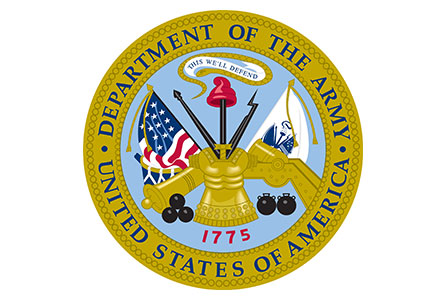CIO
U.S. Army Chief Information Officer
 OCIO hosts CGSC Information Advantage Scholar Program students
April 24, 2023
OCIO hosts CGSC Information Advantage Scholar Program students
April 24, 2023
 Army to strengthen data integration, AI capabilities ahead of 2040
April 3, 2023
Army to strengthen data integration, AI capabilities ahead of 2040
April 3, 2023
 Army, DoD leaders bid farewell to CIO
March 2, 2023
Army, DoD leaders bid farewell to CIO
March 2, 2023
 Army announces new 2022 Cloud Plan
October 17, 2022
Army announces new 2022 Cloud Plan
October 17, 2022
 Army announces consolidated Data Plan
October 13, 2022
Army announces consolidated Data Plan
October 13, 2022
 Army releases Digital Transformation Strategy
October 20, 2021
Army releases Digital Transformation Strategy
October 20, 2021
 ECMA reaches milestone with over 200 applications in CAMO
May 15, 2023
ECMA reaches milestone with over 200 applications in CAMO
May 15, 2023
 ASA(ALT) Senior Leadership Organizational Chart
May 12, 2023
ASA(ALT) Senior Leadership Organizational Chart
May 12, 2023
 U.S. Army updates anatomical representation to improve modeling
May 5, 2023
U.S. Army updates anatomical representation to improve modeling
May 5, 2023
 NETCOM ECED conducts surveys to make the AUNP and JADC2 a reality.
May 3, 2023
NETCOM ECED conducts surveys to make the AUNP and JADC2 a reality.
May 3, 2023
 Tactical comms, the Army of 2030, and developing strong leaders
May 3, 2023
Tactical comms, the Army of 2030, and developing strong leaders
May 3, 2023
 Army's air assault division ushers in network paradigm for tomorrow's battlefield
April 25, 2023
Army's air assault division ushers in network paradigm for tomorrow's battlefield
April 25, 2023
 GFEBS: life after leading the charge into the cloud
April 25, 2023
GFEBS: life after leading the charge into the cloud
April 25, 2023
 GENM-O program delivers innovation to Soldiers
April 25, 2023
GENM-O program delivers innovation to Soldiers
April 25, 2023
 DEVCOM’s administrative professionals speaker series highlights AI
April 24, 2023
DEVCOM’s administrative professionals speaker series highlights AI
April 24, 2023
 Additive Manufacturing and 3D Printing Keeps the U.S. Army Ready
April 7, 2023
Additive Manufacturing and 3D Printing Keeps the U.S. Army Ready
April 7, 2023
 Korean National Serves for 45 Years as Supply Technician with the 1st Signal Brigade
April 3, 2023
Korean National Serves for 45 Years as Supply Technician with the 1st Signal Brigade
April 3, 2023
 AUSA Symposium looks toward acquisition priorities of 2040
March 30, 2023
AUSA Symposium looks toward acquisition priorities of 2040
March 30, 2023
 U.S. Army Chief Information Officer (Acting)
Dr. David M. Markowitz
U.S. Army Chief Information Officer (Acting)
Dr. David M. Markowitz
 U.S. Army Chief Data Officer
Dr. David M. Markowitz
U.S. Army Chief Data Officer
Dr. David M. Markowitz
 Director/Chief Financial Officer, Policy, Resources & Analysis
Dr. Diana Connolly
Director/Chief Financial Officer, Policy, Resources & Analysis
Dr. Diana Connolly
 Director, Cybersecurity
Major General Jan Norris
Director, Cybersecurity
Major General Jan Norris
 Director (Acting), Architecture, Data, Standards
Mr. Kevin Coakley
Director (Acting), Architecture, Data, Standards
Mr. Kevin Coakley
 Director (Acting), Enterprise Cloud Management Agency
Mr. Greggory Judge
Director (Acting), Enterprise Cloud Management Agency
Mr. Greggory Judge
 Acting Executive Director Enterprise Services Agency
Mrs. Christine A. Hasselius
Acting Executive Director Enterprise Services Agency
Mrs. Christine A. Hasselius
 Architecture Division
Mr. George Woodard
Architecture Division
Mr. George Woodard
 Data Division
Ms. Meghan Mariman
Data Division
Ms. Meghan Mariman
 Standards and Compliance Division
Dr. Gregory Smoots
Standards and Compliance Division
Dr. Gregory Smoots
 ESA Acting Director
Mrs. Christine A. Hasselius
ESA Acting Director
Mrs. Christine A. Hasselius
 Director of Army Publishing Directorate
Mr. Perry C. Clark
Director of Army Publishing Directorate
Mr. Perry C. Clark
 Director, Army Declassification Directorate
Mr. Michael VanDriel
Director, Army Declassification Directorate
Mr. Michael VanDriel
 Director, Army Records Management Directorate
Ms. Joyce Luton
Director, Army Records Management Directorate
Ms. Joyce Luton
 DIRECTOR/CHIEF FINANCIAL OFFICER, POLICY, RESOURCES & ANALYSIS
Dr. Diana Connolly
DIRECTOR/CHIEF FINANCIAL OFFICER, POLICY, RESOURCES & ANALYSIS
Dr. Diana Connolly